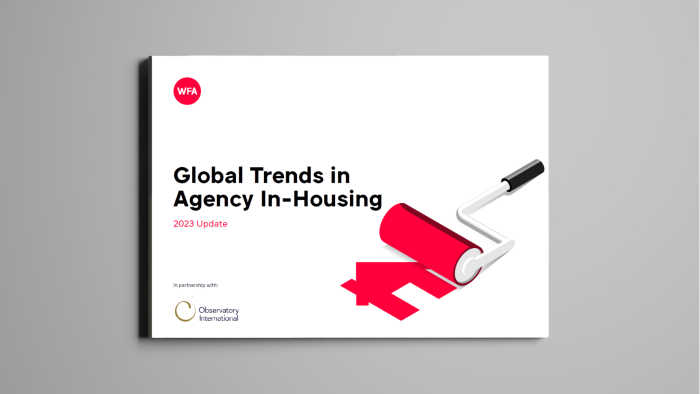Get analysis, insight & opinions from the world's top marketers.
Sign up to our newsletter.
According to a recent survey conducted by WFA and The Observatory International, 66% of brands now have in-house agencies, with 21% actively considering one. According to that same survey, 70% already have strategic capabilities in-house and many plan to shift new tasks from external agencies over the next three years.

Two-thirds of major multinationals now have an in-house agency and a further 21% are considering establishing one.
The 66% figure represents a 16% rise on the number with these resources in 2020, the last time that this research was carried out. The number considering the in-house option is also up from 17% in 2020.
While most of these units are relatively fresh – nearly three quarters are between 1-5 years old – their skills are expanding and 70% of respondents now claim to have some form of strategic capabilities in-house – be it brand, creative or media, up from 65% in 2020.
The research suggests that many are also planning to expand the range and scale of their in-house operations. Over the next three years, 56% of respondents expect to move more digital production from external agencies to in-house, 33% of respondents expect to more offline production, 22% expect to transfer more data strategy work and 11% plan to move more data management and insight and analytics tasks over.
Online planning and buying are indicated as being additional areas of future growth, with 83% of respondents expecting to handle some social media buying in-house over the next three years (up from 37% right now), 67% planning to add social media planning (up from 48%) and 50% want to take on digital media planning and buying tasks (up from 33% and 26% respectively).
The results are based on responses from 45 companies, with an estimated annual global ad spend of $60 billion. Seven percent of respondents are spending more than $50m annually on their in-house agencies, the same percentage spend $25-50m, 33% spend $5-$25m, 13% budget $1m-$5m and 27% spend less than $1m.
While cost efficiencies appears to remain the strongest motivation behind the growth in the in-house function (83%), other factors such as quicker and more agile processes (76%), better integration (59%) and increased brand knowledge (59%) are also driving adoption.
Overall satisfaction with the work produced by these agencies is high at 86% and there was a significant rise in “complete satisfaction” – up from 23% on 2020 to 33% in 2023.
All respondents continue to work with external agencies, many of whom are still used to help deliver when in-house capacity is stretched.
“The rise of the in-house agency is one of the big changes in the way big brands manage their communications needs over recent years. While cost has been an initial driver of the trend, successful operations are demonstrating that they can deliver significant additional benefits such as speed of response. Greater maturity of the sector is also giving brands more confidence to expand their operations both in terms of scale and capabilities”, said Stephan Loerke, CEO of WFA.
One notable finding, however, is that the performance of in-house agencies is not measured on the same basis as those applied to external agencies, which are typically assessed on effectiveness. In-house measurement remains more focused on outputs than outcomes with the top three KPIs being 1) 67% quality of work, 2) 47% speed to market and 3) 40% cost savings.
Other key findings include:
“Given budget pressures and a desire for faster, more efficient delivery of assets at lower cost, it’s unsurprising that the growth of those developing in-house offerings continues unabated. The rationale is obvious and benefits are considerable when you get it right. But if there is a ‘watch-out’, then it’s that, especially with content, businesses need to make sure they are not simply producing ‘stuff’ to fill expectation rather than need. Effectiveness is key to make sure that all your efforts aren’t simply wasted and potentially detrimental to both your business and, given the carbon footprint of digital activity, the planet”, said Stuart Pocock, co-founder of The Observatory International.
WFA member? Download the report here.
The Observatory International is the leading global management consultancy dedicated to helping companies maximise their marketing and communications resources. The Observatory International brings global and local perspectives to marketers along with the knowledge required to overcome the challenges associated with managing communications agencies in these dynamic times. With years of experience working with many of the world’s leading brands and agencies, our casebook is full of best practice on how to get the most out of your marketing resources.
For more information or questions, please contact us

